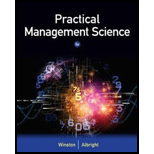
Practical Management Science
5th Edition
ISBN: 9781305250901
Author: Wayne L. Winston, S. Christian Albright
Publisher: Cengage Learning
expand_more
expand_more
format_list_bulleted
Concept explainers
Question
Chapter 13, Problem 46P
Summary Introduction
To determine: The number of postal windows that should be opened to minimize the hourly costs.
Introduction: In order to predict the waiting time and length of the queue, queueing model will be framed. Queueing theory is the mathematical model that can be used for the decision-making process regarding the resources required to provide a service.
Expert Solution & Answer
Explanation of Solution
Model:

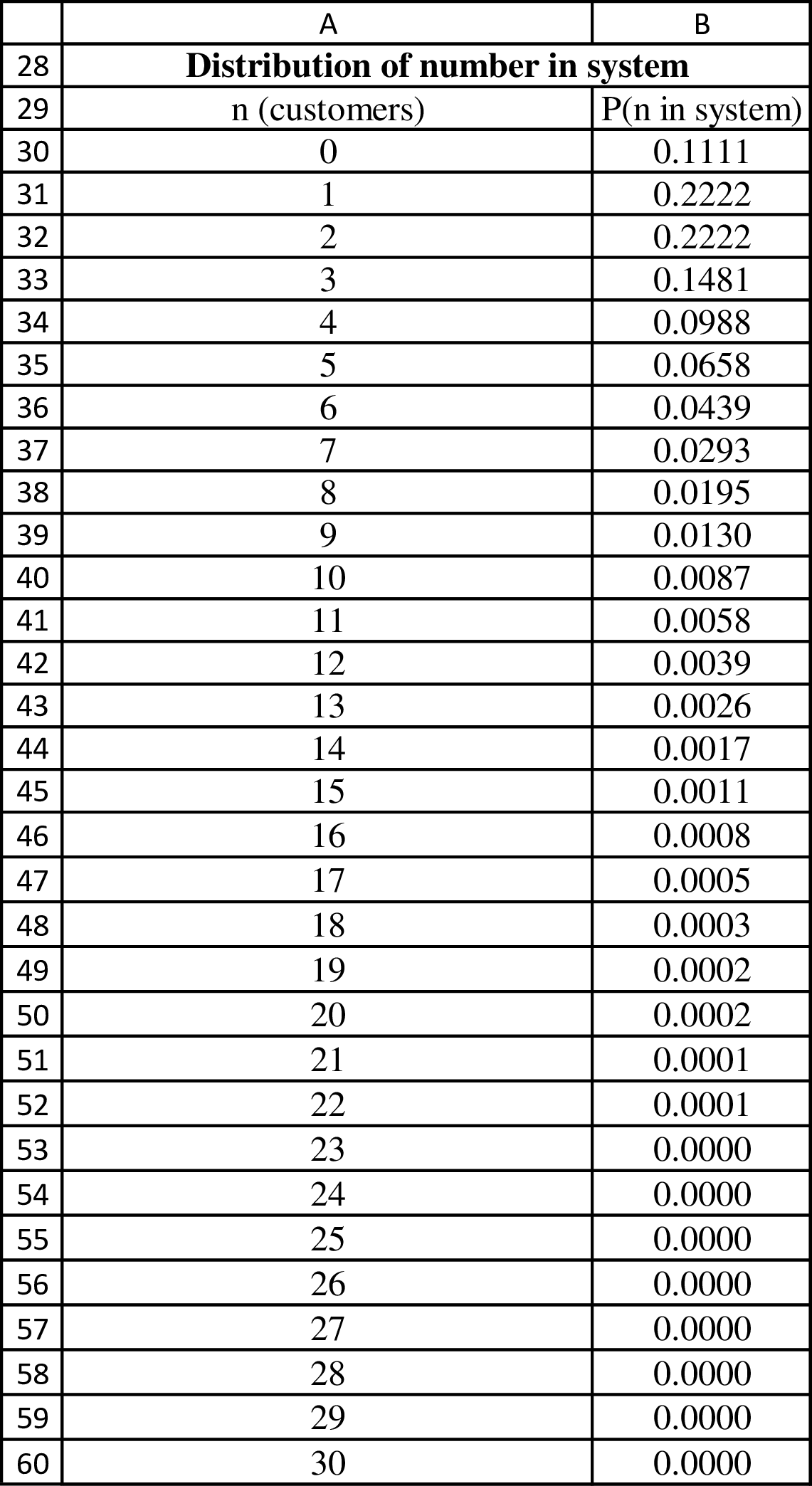
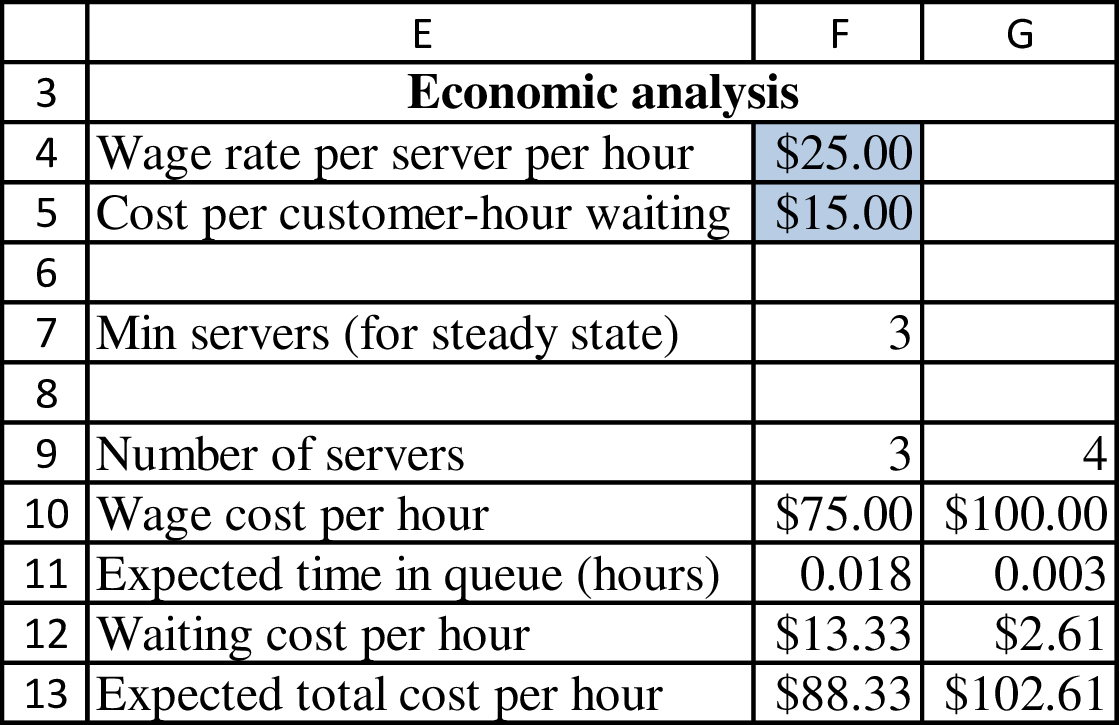
Formulae to determine the model:
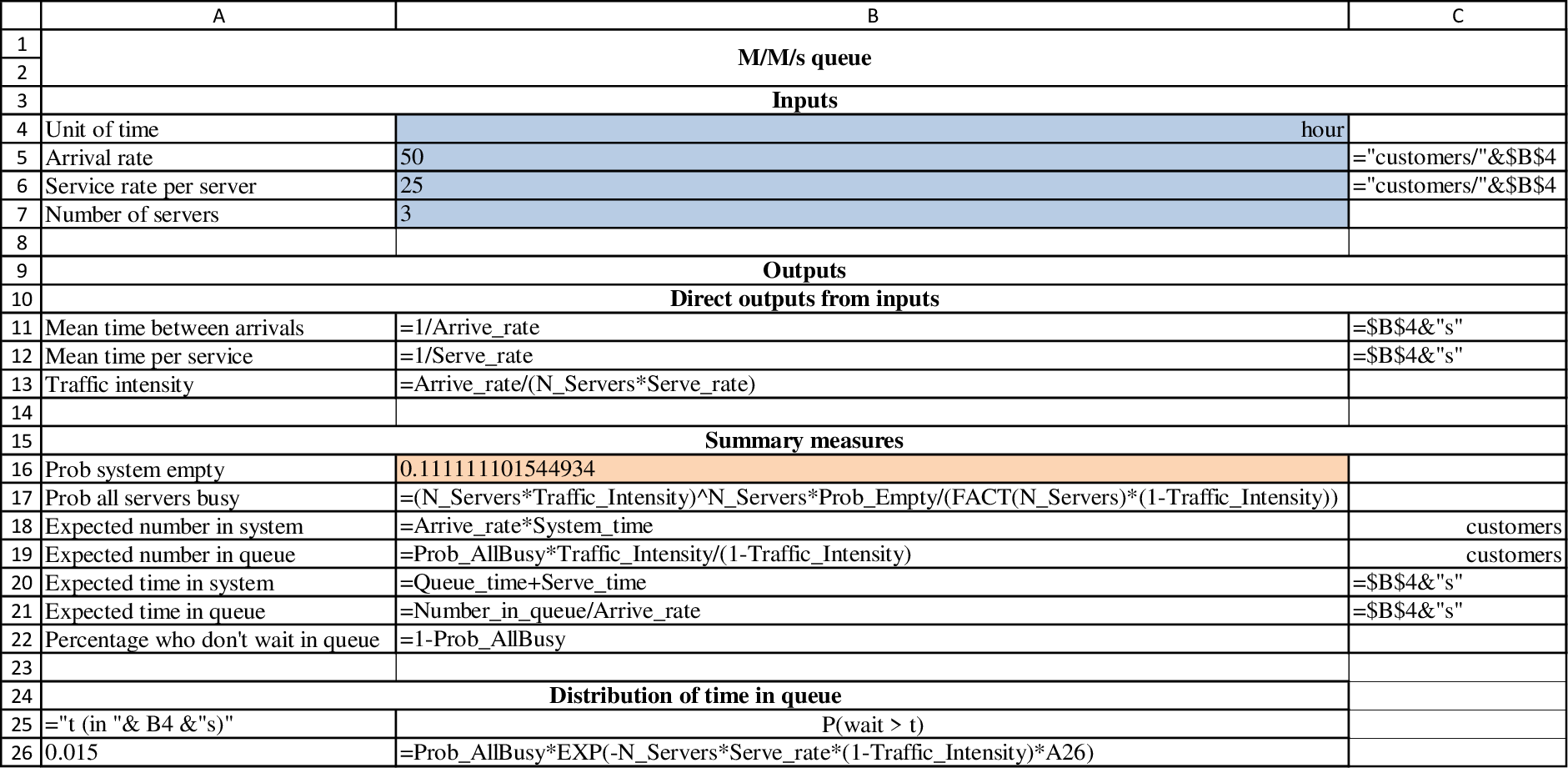
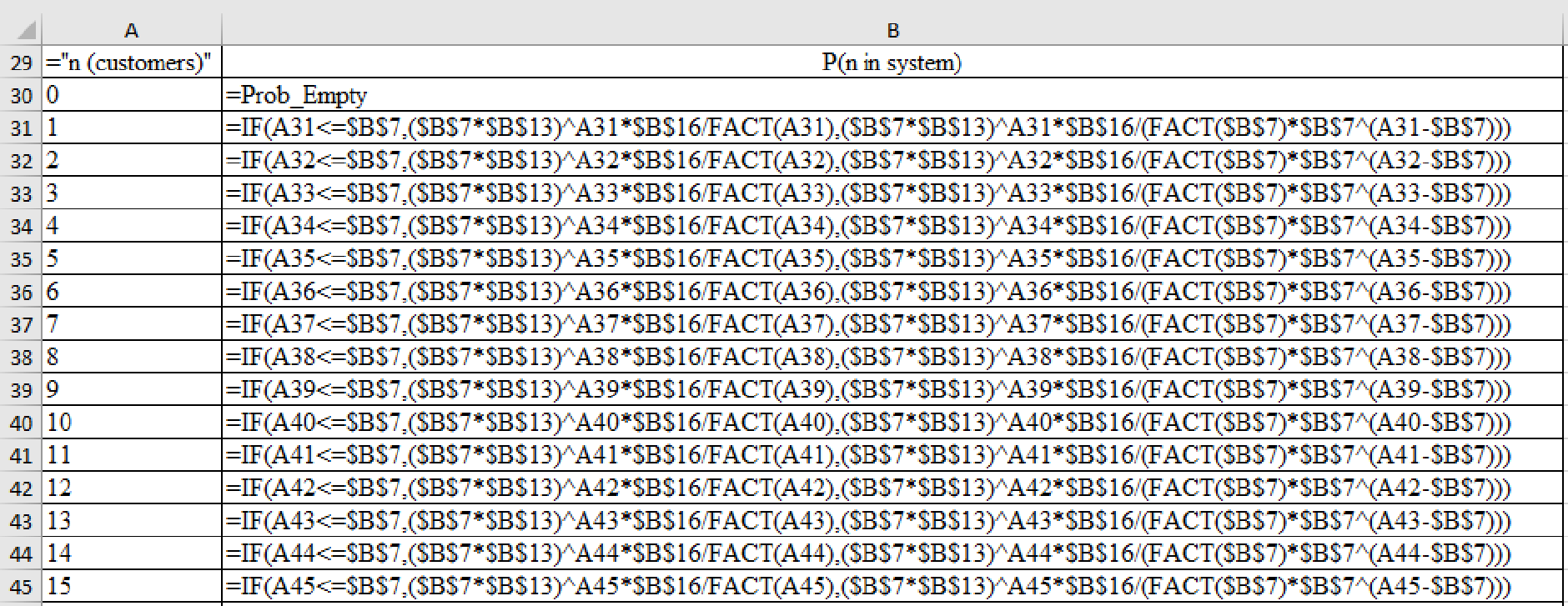
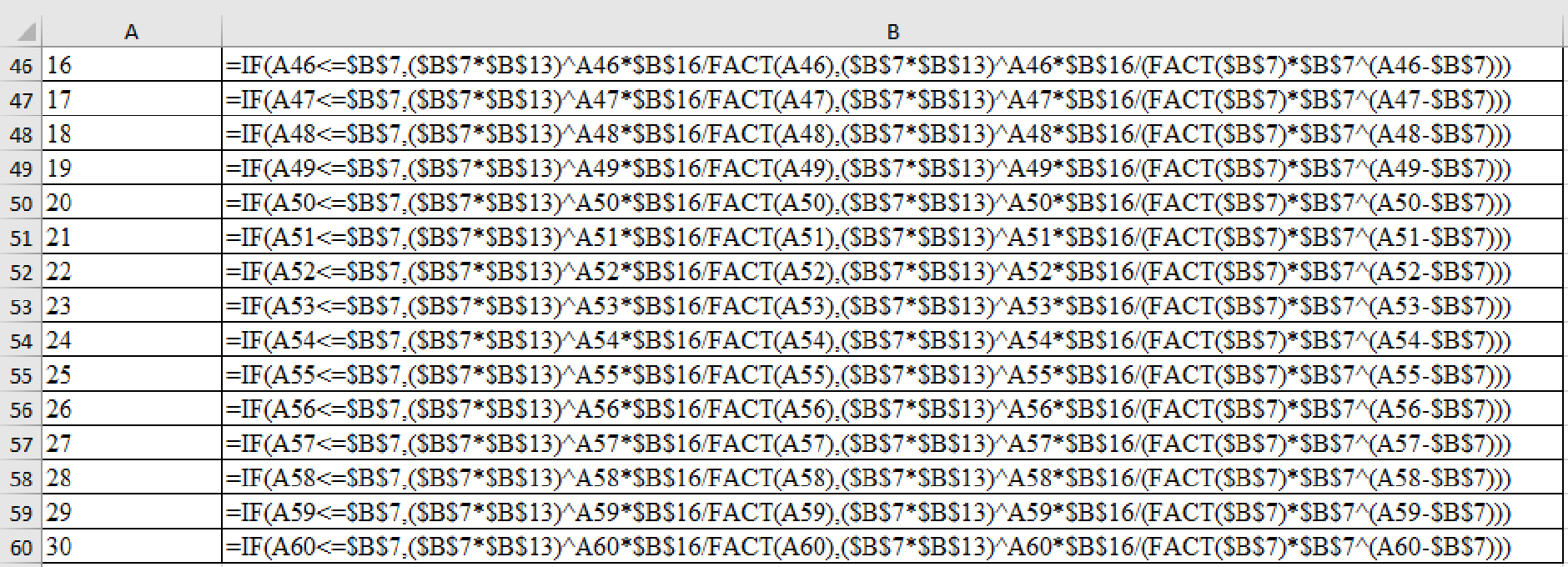

Three postal windows should be opened in order to minimize the hourly costs
Want to see more full solutions like this?
Subscribe now to access step-by-step solutions to millions of textbook problems written by subject matter experts!
Students have asked these similar questions
Question 3
i.
Using the Center of Gravity method, determine the optimal location (X, Y) for the new
distribution center.
[7 marks]
[TOTAL 25 MARKS]
Time (sec.)
Power steering assembly firm wants to set up an assembly line which must have an output of 60 units per
hour. The work elements, task times and their precedence relationships are shown in Table 2: Table 1
Work Element
Immediate Predecessor(s)
A
30
NONE
B
26
A
C
50
A
D
44
B
E
10
с
F
20
с
G
15
D.E
H
30
E,G,F
Required:
a. Draw the precedence diagram showing the task precedence and their times
b. Determine the cycle time associated with the rate of output required.
[3 marks]
c. What is the theoretical number of work stations required to satisfy this output rate?
[3 marks]
[4 marks]
d. Allocate the tasks to work stations taking into consideration the precedence requirements and using
the
LOT rule to break ties between feasible tasks.
e. Calculate the total idle time
[8 marks]
[3 marks]
f. What is the efficiency of the line and the…
Question 2
MGMT2026 Production and Operations Management Semester II 2024-2025
a. Aman ltd. desires to locate a new facility. Based on preliminary analysis, the choice has been
reduced to four locations: A, B, C, and D. These four locations were rated on a scale from 1
(worst) to 10 (best) on each of four criteria. Each criterion was also weighted to indicate its
importance (i.e., the higher the weight, the more important). The list of ratings and weights
follows in the Table 2 below:
Table 2
Factor Score Evaluation by Location
Criterion
Weights
A
B
с
D
Wages
25
4
5
3
4
Government Policies
30
8
7
6
5
Unionisation
Weather
15
6
4
3
2
30
3
4
6
5
i.
Based on weighted scores, where should Acme locate its new facility?
[6 marks]
b. An operations manager has narrowed down the search for a new factory to three locations. The
fixed and variable costs associated with each location is given in the table below.
i.
Table 3
Location
Fixed Cost
Variable Cost
A
$100,000
$10
B
$150,000
$7
с
$200,000
$5…
The University of the West
Indies
GLOBAL CAMPUS
MGMT 2026 Production and Operations Management - Problem Sheet
Assignment Semester II
2024/2025
Note:
Although this assignment is being currently assessed out of 100 marks it
would be prorated to
Contribute a maximum of 40% towards your final course marks.
M&H company ltd. sells television sets and has collected monthly sales
data (in units) for the past 12 months as shown in table 1below:
TABLE 1
Month
Sales (Units)
1
120
2
135
3
150
165
5
180
200
7
195
8
210
225
10
240
11
255
12
270
This Assignment is comprised of four (4) Questions - All questions
must be attempted
Using the data provided, answer the following questions:
a. Using a 3-month weighted moving average with weights 0.5, 0.3,
and 0.2 (most recent month having the highest weight), calculate
the forecast for month 13.
[2 marks]
Screens 5-7 of 7
Chapter 13 Solutions
Practical Management Science
Ch. 13.3 - Prob. 1PCh. 13.3 - Prob. 2PCh. 13.3 - Prob. 3PCh. 13.3 - Prob. 4PCh. 13.4 - Prob. 5PCh. 13.4 - Prob. 6PCh. 13.4 - Prob. 7PCh. 13.4 - Prob. 8PCh. 13.5 - Prob. 9PCh. 13.5 - Prob. 10P
Ch. 13.5 - Prob. 11PCh. 13.5 - Prob. 12PCh. 13.5 - Prob. 13PCh. 13.5 - Prob. 14PCh. 13.5 - Prob. 15PCh. 13.5 - Prob. 16PCh. 13.5 - Prob. 17PCh. 13.5 - Prob. 18PCh. 13.5 - Prob. 19PCh. 13.5 - Prob. 20PCh. 13.5 - Prob. 21PCh. 13.5 - Prob. 22PCh. 13.5 - Prob. 23PCh. 13.5 - Prob. 24PCh. 13.5 - Prob. 25PCh. 13.5 - Prob. 26PCh. 13.5 - Prob. 27PCh. 13.5 - Prob. 28PCh. 13.5 - Prob. 29PCh. 13.5 - Prob. 30PCh. 13.5 - Prob. 31PCh. 13.5 - Prob. 32PCh. 13.5 - Prob. 33PCh. 13.5 - Prob. 34PCh. 13.5 - Prob. 35PCh. 13.5 - Prob. 36PCh. 13.5 - Prob. 37PCh. 13 - Prob. 46PCh. 13 - Prob. 47PCh. 13 - Prob. 48PCh. 13 - Prob. 49PCh. 13 - Prob. 50PCh. 13 - Prob. 51PCh. 13 - Prob. 52PCh. 13 - Prob. 54PCh. 13 - Prob. 58PCh. 13 - Prob. 59P
Knowledge Booster
Learn more about
Need a deep-dive on the concept behind this application? Look no further. Learn more about this topic, operations-management and related others by exploring similar questions and additional content below.Similar questions
- Gas sales across type: 80% of gas sales tend to be regular. 15% midgrade, 5% tend to be premium. $0.10 increase in price per gallon tends to decrease gallons sold by 1 to 3%. Jan-0.87, Feb-0.95, Mar-1.00, Apr-1.05, May-1.08, Jun1.15, Jul-1.13, Aug-1.07, Sep-1.02, Oct-0.94, Nov-0.89, Dec-0.85. You want the MAPE to be below 20%, if ypu can get it to or below 10% they'll throw in extra $10k. Wont get bonus if it is above 11% or 20%. It cannot be over 20%.arrow_forwardhelp me choose the correct path please. There are other optionsarrow_forwardNegotiators can gain several benefits from using the strategy of multiple equivalent simultaneous offers. By offering multiple options it reduces the chance of rejection. It also improves the chances of reaching reaching an agreement. By presenting multiple offers, it shows you are flexible. agree with the postarrow_forward
- Negotiators can gain several benefits from using the strategy of multiple equivalent simultaneous offers. By offering multiple options it reduces the chance of rejection. It also improves the chances of reaching reaching an agreement. By presenting multiple offers, it shows you are flexible. disagree with this post or add on to the postarrow_forwardThe strategy of Multiple Equivalent Simultaneous Offers involves presenting several equally valuable options to the other party during negotiations. This approach benefits negotiators by creating flexibility and increasing the chances of finding a mutually agreeable solution. By offering multiple options, negotiators show that they are open to compromise, which can build trust and make the negotiation process smoother. It also helps avoid getting stuck on one issue, as the other party can choose from several alternatives that meet their needs. In my experience, using MESOs in a work negotiation helped both parties reach an agreement more quickly because each option was carefully thought out to address different needs, and this made it easier for us to settle on one that worked for both sides. This strategy can also reveal what is most important to the other party, helping negotiators understand their priorities better. agree or disagree with the postarrow_forwardExamine the conflicts between improving customer service levels and controlling costs in sales. Strategies to Balance Both customer service levels and controlling costs in sales 1.Outsourcing and workforce optimization 2. AI-driven customer supportarrow_forward
- how can you gain trust in a negotiation setting?arrow_forward✓ Custom $€ .0 .on File Home Insert Share Page Layout Formulas Data Review View Help Draw Arial 10 B B14 ✓ X✓ fx 1400 > 甘く 曲 > 冠 > Comments Editing ✓ . . . P Q R S T 3 A Production cost ($/unit) B с D E F G H J K L M N $74.00 4 Inventory holding cost ($/unit) $1.50 5 Lost sales cost ($/unit) $82.00 6 Overtime cost ($/unit) $6.80 7 Undertime cost ($/unit) $3.20 8 Rate change cost ($/unit) $5.00 9 Normal production rate (units) 2,000 10 Ending inventory (previous Dec.) 800 11 Cumulative 12 13 Month Demand Cumulative Demand Product Production Availability Ending Inventory Lost Cumulative Cumulative Product Sales 14 January 1,400 1,475 15 FUERANZ222222223323333BRUINE 14 February 1,000 2,275 Month January February Demand Demand Production Availability Ending Inventory Lost Sales 1,400 #N/A 1,475 #N/A #N/A #N/A 1,000 #N/A 2,275 #N/A #N/A #N/A 16 March 1,800 2,275 March 1,800 #N/A 2,275 #N/A #N/A #N/A 17 April 2,700 2,275 April 2,700 #N/A 2,275 #N/A #N/A #N/A 18 May 3,000 2,275 May 3,000 #N/A…arrow_forwardFollow guidelines and summarize in a paragrapharrow_forward
arrow_back_ios
SEE MORE QUESTIONS
arrow_forward_ios
Recommended textbooks for you
 Practical Management ScienceOperations ManagementISBN:9781337406659Author:WINSTON, Wayne L.Publisher:Cengage,MarketingMarketingISBN:9780357033791Author:Pride, William MPublisher:South Western Educational Publishing
Practical Management ScienceOperations ManagementISBN:9781337406659Author:WINSTON, Wayne L.Publisher:Cengage,MarketingMarketingISBN:9780357033791Author:Pride, William MPublisher:South Western Educational Publishing

Practical Management Science
Operations Management
ISBN:9781337406659
Author:WINSTON, Wayne L.
Publisher:Cengage,

Marketing
Marketing
ISBN:9780357033791
Author:Pride, William M
Publisher:South Western Educational Publishing
